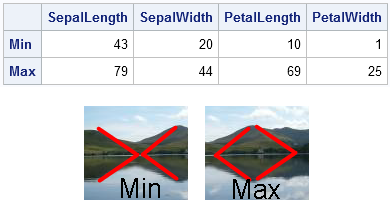The title of this article makes no sense. How can the number of elements (in fact, the number of anything!) not be a whole number? In fact, it can't. However, the title refers to the fact that you might compute a quantity that ought to be an integer, but is
Tag: Statistical Programming

Sometimes I get contacted by SAS/IML programmers who discover that the SAS/IML language does not provide built-in support for multiplication of matrices that have missing values. (SAS/IML does support elementwise operations with missing values.) I usually respond by asking what they are trying to accomplish, because mathematically matrix multiplication with

SAS procedures usually handle missing values automatically. Univariate procedures such as PROC MEANS automatically delete missing values when computing basic descriptive statistics. Many multivariate procedures such as PROC REG delete an entire observation if any variable in the analysis has a missing value. This is called listwise deletion or using

The SAS DATA step supports multidimensional arrays. However, matrices in SAS/IML are like mathematical matrices: they are always two dimensional. In simulation studies you might need to generate and store thousands of matrices for a later statistical analysis of their properties. How can you accomplish that unless you can create

In SAS, the order of variables in a data set is usually unimportant. However, occasionally SAS programmers need to reorder the variables in order to make a special graph or to simplify a computation. Reordering variables in the DATA step is slightly tricky. There are Knowledge Base articles about how
A SAS/IML programmer asked a question on a discussion forum, which I paraphrase below: I've written a SAS/IML function that takes several arguments. Some of the arguments have default values. When the module is called, I want to compute some quantity, but I only want to compute it for the

A SAS programmer recently posted a question to the SAS/IML Support Community about how to compute the kth smallest value in a vector of numbers. In the DATA step, you can use the SMALLEST function to find the smallest value in an array, but there is no equivalent built-in function

Like most programming languages, the SAS/IML language has many functions. However, the SAS/IML language also has quite a few operators. Operators can act on a matrix or on rows or columns of a matrix. They are less intuitive, but can be quite powerful because they enable you perform computations without

A common question on SAS discussion forums is how to compute the minimum and maximum values across several variables. It is easy to compute statistics across rows by using the DATA step. This article shows how to compute the minimum and maximum values for each observation (across variables) and, for

SAS/IML 13.1 includes a handy function for programmers who write a lot of modules. The PARENTNAME function obtains the name of the symbol that was passed in as a parameter to a user-defined module. How is this useful? Well, suppose that you want to create a SAS/IML module that prints
